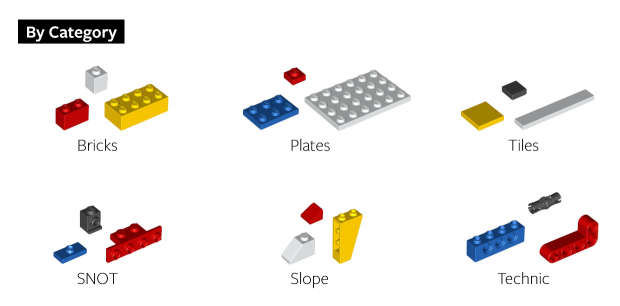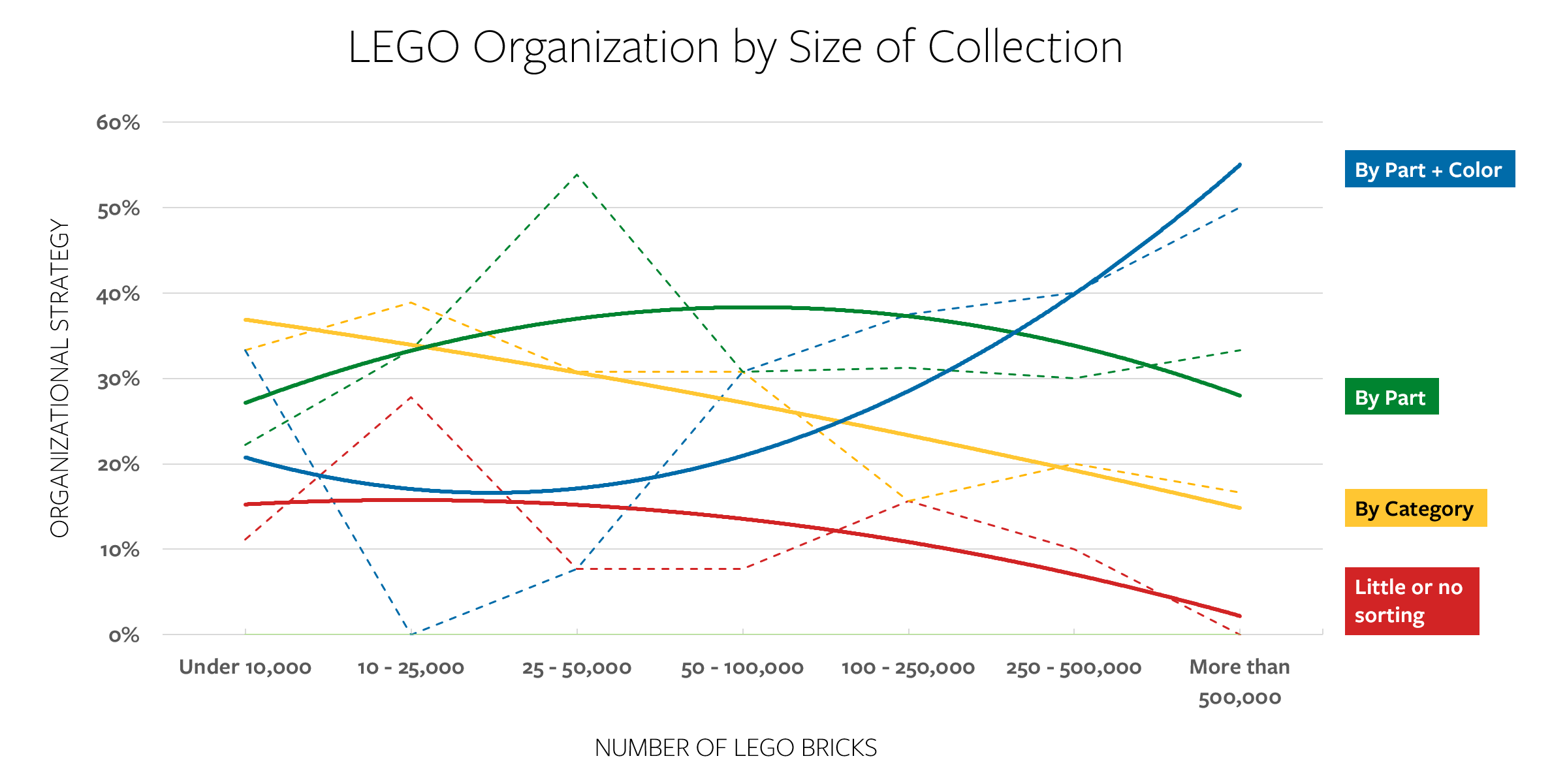Chapter 2: Organizing your LEGO Bricks
Levels of Organization
Along the way, many people end up purchasing LEGO storage solutions that they outgrow or don’t work well. Even if you only have a small collection now, this guide helps you avoid common pitfalls by selecting an appropriate storage solution for your current collection which you can continue to use as your collection grows.
We’re going to to explore the most common ways to organize a LEGO collection, following the normal progression from no organization, to sorting by categories, and ultimately organizing by part.
No organization
When you have a limited number of bricks, it’s easier to find what you’re looking for. This is especially true for the small LEGO collections of young kids—organizing a 6-year old’s LEGO bricks probably won’t help them be more creative!
You will find the best storage solutions for small LEGO collections that don’t require any organization in Chapter 3: LEGO Storage for Small Collections.
Organizing into groups
If it becomes frustrating to find specific LEGO pieces because your collection has grown too large, it might be time to organize your collection into groups of related parts. Even if you aren’t keen to organize your bricks, it’s probably a good time to organize your parts into broad groups when your collection grows too large to fit in a single container.

Most LEGO builders recommend that you start by sorting your LEGO parts by category rather than by color.
Organizational groups:
- Organizing by Color – Almost everyone begins by sorting their LEGO bricks by color. Unfortunately, most LEGO builders quickly discover that this makes it really hard to find a specific small part, as it’s hard to pick out a specific small part in a container full of bricks of the same color.
- Organizing by Category – As you become familiar with common LEGO parts, you should try sorting them into categories based on their type. A good place to start would be to separate ‘Bricks’, ‘Plates’, and ‘Other’ LEGO parts into three different containers. (Even if you only have three categories, the next time you are looking for a specific part, you only need to dig through 1/3 as many parts since you know which of the three containers it should be in.)
As your collection continues to grow, you can make the categories more precise using additional storage containers. (For example, splitting a container filled with ‘Plates’ into ‘1x Plates’, ‘2x Plates’, and ‘Large Plates’.)
Whether you decide to sort by color, or by category, you will find storage suggestions in Chapter 4: LEGO Storage for Medium Collections.
Organizing by Part
As your collection grows even larger, sorting into categories will stop making sense — you’ll need to keep breaking categories into sub-categories as you get more and more pieces. Eventually, you will decide to sort the majority of your collection into separate containers for each unique part.
By Part vs. By Element:
- By Part – If you sort by part, you will have a single container with identical parts that vary only in color. This is sufficient for most large collections, because It is easy for most people to distinguish between colors (making it unnecessary to also sort parts by color).
- By Part + Color (By Element) – If you have a very large collection, you might have enough of the most common parts that you decide to also sort common parts by color. This is how LEGO parts are sorted at the LEGO Headquarters in Billund, Denmark. (Unless you have one of the largest private LEGO collections in the world, you are unlikely to sort anything beyond basic bricks, plates, and cheese slopes by both part and color.)
I’ve collected the best storage suggestions for collections sorted by Part (or by Element) in Chapter 5: LEGO Storage for Large Collections.
Where should I start?
By reading many discussions about LEGO storage and talking with LEGO builders at conventions, I’ve learned that biggest influence on the organizational strategies and storage solutions people pick is the size of their LEGO collection.
While there are many organizational approaches you can try on the journey from a small LEGO collection to a collection with thousands of LEGO bricks, I’ve prepared the following suggestions based on the size of your LEGO collection.



Hello,
Really nice article. I am wondering about your thoughts on the organisation when dealing with just 1 set. If you were to build say the Tree House at 3036 pieces but not from numbered bags what would you do?
Would you just build from a massive pile which gets easier as you whittle down the pieces but is a pain initially. Or would you use a sorting method (if so, which one) before and hope that the time spent to sort is made up by the reduction in building time as pieces are easier to find?
Thanks
I would do a little sorting when building a big set like that without the numbered bags, but sorting it perfectly before you start probably isn’t worth it. The same guidelines still apply – sort by part shape instead of color, since you can easily find different colors of similar parts later when actually building the set.
Good luck, and happy building!
This very much follows the progression of my collection. As a child, I just had a big bin and would empty it onto the floor and sift through it. My collection grew rapidly when I started making large mocs as I did not want to break down other things in the collection to make them. I am now a somewhere in the region of 200,000 bricks in sets/mocs and normally about 40,000 or so in spares.
I always design in Studio first, so although I use drawers, they do not have to be structured beyond being numbered. If a part/colour does not have a drawer yet I can assign it to a random empty one. I then log the parts using brickstore/bricklink noting the draw number in remarks. If I need a part I can then simply search by part number in the catalogue and see what draw it is in. I generally assign a part to a draw until either it fills enough to need splitting into colours also or if there are colours that are too close to each other.
The initial organise is a bit painful but you just do an hour here and there and slowly it comes together. The more parts in the collection the easier it gets as you are simply adding them to existing drawers instead of having to create new ones. The really great thing about using bricklink as a cataloguing tool is that you can quickly work out parts you have and what is needed, filtering your wanted list through your own catalgue before buying more.
William,
Your approach is something that I have heard about from many Bricklink sellers, as it is an efficient way to organize your inventory without wasting space by having bins which are not full.
I have also head about this from a few LEGO builders, but it is almost always digital-first builders like yourself that prefer this system. If I’m correct in my understanding, once you decide that you want to build something you built digitally, you simply create a ‘pull list’ just like a Bricklink seller, and it tells you exactly where to go and how many pieces to take.
While this approach remains uncommon for LEGO builders, it is something that is common enough that I should probably add a small section to my guide explaining how it works.
Thanks for taking the time to reply and adding more ideas to the world of LEGO storage!
—Tom
Tom,
I posted on Reddit to you but I also wanted to ask/add here. Can we have a none specific to specific printable breakdown?
Category has a picture breakdown. I can print those labels put and start my sorting.
Then could we have a breakdown of part pictures that fall under each category? The amazing complexity of all the detailed pictures has a beginning sorter very overwhelmed. ❤️
I also replied in Reddit, but yes – I think it would make sense to provide a ‘sorting guide’ that complements the label collection. No promises on when that would be ready, but it is a good idea!
Hello, any update on this printable resource? Thank you!
I do have an update – In my January 2024 News Roundup, I shared some details of my upcoming LEGO Parts Guide. The functionality you are looking for will be a future feature of the guide. I’m not sure how quickly I will add that capability, but it is something that I know will be valuable for folks like yourself!
Tom – this is an amazing resource and I cannot thank you enough. My son (13) and I have gained quite the collection and it kind of got away from us before we realized the need for real organization… and it was a mountain of a task. Yes, your thoughtful and insightful guide has been instrumental to our process. More than that, this has also been great for understanding of the why and how to the organization (which has helped my spouse jump in and get on board as well). A million thanks!